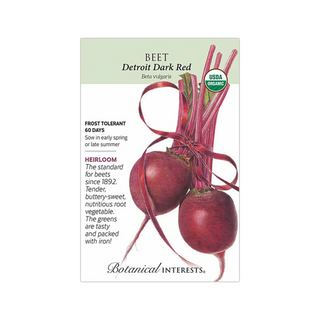
Description
Home-grown beets are simply the best. Tender and delicious, these 2-1/2" - 3" beautiful, deep crimson beets do not get woody as do smaller varieties if allowed to grow large. Perfect for pickling, roasting and even raw in salads! The greens rival chard and spinach for tenderness and flavor, are very nutritious. Beet seed is actually a dried fruit with 1 to 5 seeds in each fruit, so make sure to thin!
Variety Info
- Days to Maturity: 60 days
- Family: Amaranthaceae
- Type: Beet
- Native: Europe, Asia, and the Mediterranean region
- Hardiness: Frost-tolerant biennial grown as an annual
- Exposure: Full sun
- Plant Dimensions: Leaf tops to 12"–18" tall
- Variety Info: 2 ½"–3" blood red, globe shaped. Leaf tops are dark green on red stems. Introduced in 1892, 'Detroit Dark Red' is the standard for beets. It has particularly good tasting greens, and withstands fluctuations in temperature quite well.
- Attributes: Frost Tolerant
Sowing Info
- When to Sow Outside: RECOMMENDED. 2 to 4 weeks before your average last frost date, when soil temperature is at least 45°F, ideally 60°–85°F, for early summer crop. 6 to 8 weeks before your average first fall frost date for late summer/fall crop. Mild Climates: Sow fall through winter.
- When to Start Inside: Not recommended. Root disturbance delays maturity.
- Days to Emerge: 5 – 21 days
- Seed Depth: ½"
- Seed Spacing: 1 seed every 4"
- Row Spacing: 12"
- Thinning: When 2" tall, thin to 1 every 4"
Growing Info
- Harvesting: For early spring sowings, harvest beets before summer heat. For late summer sowings, harvest before first heavy freeze. For winter sowings in mild climates, harvest in early spring. Harvest when roots are anywhere from 1"-3" in diameter. The smaller they are, the more tender. Greens are most tender when small, so start harvesting when they are 2" tall. You can take as much as one third of a beet plant's outer leaves without harming the root crop.
Description
Home-grown beets are simply the best. Tender and delicious, these 2-1/2" - 3" beautiful, deep crimson beets do not get woody as do smaller varieties if allowed to grow large. Perfect for pickling, roasting and even raw in salads! The greens rival chard and spinach for tenderness and flavor, are very nutritious. Beet seed is actually a dried fruit with 1 to 5 seeds in each fruit, so make sure to thin!
Variety Info
- Days to Maturity: 60 days
- Family: Amaranthaceae
- Type: Beet
- Native: Europe, Asia, and the Mediterranean region
- Hardiness: Frost-tolerant biennial grown as an annual
- Exposure: Full sun
- Plant Dimensions: Leaf tops to 12"–18" tall
- Variety Info: 2 ½"–3" blood red, globe shaped. Leaf tops are dark green on red stems. Introduced in 1892, 'Detroit Dark Red' is the standard for beets. It has particularly good tasting greens, and withstands fluctuations in temperature quite well.
- Attributes: Frost Tolerant
Sowing Info
- When to Sow Outside: RECOMMENDED. 2 to 4 weeks before your average last frost date, when soil temperature is at least 45°F, ideally 60°–85°F, for early summer crop. 6 to 8 weeks before your average first fall frost date for late summer/fall crop. Mild Climates: Sow fall through winter.
- When to Start Inside: Not recommended. Root disturbance delays maturity.
- Days to Emerge: 5 – 21 days
- Seed Depth: ½"
- Seed Spacing: 1 seed every 4"
- Row Spacing: 12"
- Thinning: When 2" tall, thin to 1 every 4"
Growing Info
- Harvesting: For early spring sowings, harvest beets before summer heat. For late summer sowings, harvest before first heavy freeze. For winter sowings in mild climates, harvest in early spring. Harvest when roots are anywhere from 1"-3" in diameter. The smaller they are, the more tender. Greens are most tender when small, so start harvesting when they are 2" tall. You can take as much as one third of a beet plant's outer leaves without harming the root crop.

